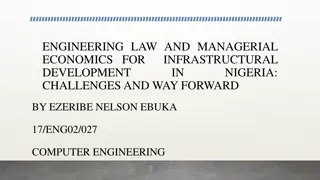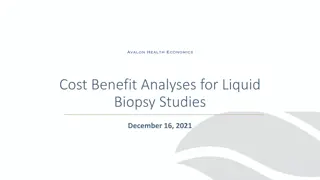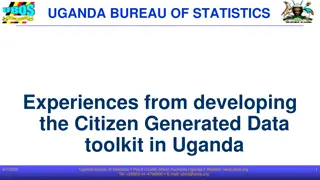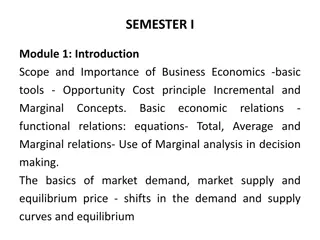Cost Economics and Emerging Business Models in CGD Sector: Engineering a Better Tomorrow Over Five Decades
Factors such as the competitiveness of natural gas, growth in energy demand, government initiatives, key cost components, and cost competitiveness of alternative fuels like hydrogen and bio-CNG are shaping the landscape of City Gas Distribution (CGD) projects in India. These projects aim to increase the share of natural gas in the country's energy mix and expand the city gas network to various districts, highlighting the potential for economic and environmental benefits in the future.
Download Presentation

Please find below an Image/Link to download the presentation.
The content on the website is provided AS IS for your information and personal use only. It may not be sold, licensed, or shared on other websites without obtaining consent from the author. Download presentation by click this link. If you encounter any issues during the download, it is possible that the publisher has removed the file from their server.
E N D
Presentation Transcript
COST ECONOMICS AND EMERGING BUSINESS MODELS IN CGD SECTOR ENGINEERING A BETTER TOMORROW OVER FIVE DECADES Presented By: Shireesh S. Swami Date: 21-01-2021 CONFIDENTIAL 1
Factors determining the Viability of CGD Projects Natural gas is cheaper by 30-40% than petrol / diesel, convenient and environment friendly and its greater use will help cut dependence on oil imports. India s energy demand is expected to grow at 4.2% each year over the next 25 years 11th round of CGD bidding is planned around a new pipeline under construction from Angul in Odisha to Mumbai in Maharashtra to ferry natural gas between the east and west coasts. 50-100 districts, in Chhattisgarh, Madhya Pradesh, and Vidharba region of Maharashtra, will join the city gas network after the 11th round. The push for city gas expansion is part of the government plan for raising the share of natural gas in the country's energy basket to 15% by 2030 from the current 6.3% Households connected with piped cooking gas is targeted to rise to 5 crore in coming years from the current 62.5 lakh. Governments push for using LNG as fuel in trucks and buses resulting in setting up of 100 LNG stations on the Golden Quadrilateral connecting the metro cities and on North-South, East-West highway corridors and in mining blocks. Around Rs 1.2 trillion will be invested by 2030 in rolling-out city gas network in almost 300 districts for which licenses have been granted in 9th and 10th bidding rounds. Government wants to ensure a gas pipeline network from Kutch to Kohima and Kashmir to Kochi and around Rs 4 lakh crore worth of investment is likely to be made in such projects. Confidential 2
Key Cost Components of CGD Project Following are some of the key cost components for setting up City Gas Distribution & CNG station; Land Cost: Land parcel for setting up City Gate and CNG Station continues to be the major cost component and availability is getting difficult especially near the cities. Gas supply Cost: One of the constraints for the Indian CGD industry is the availability of natural gas as the decision to allocate the natural gas supply is with the government authorities. The price of natural gas available domestically and that of liquefied natural gas (LNG) differs. Therefore the supply option has an impact on investment analysis. Infrastructure Cost: Includes tapping from existing pipeline, pressure reducing station cost, cost of piping (steel), cathodic protection, District regulating station, Cost of odorizing system, etc. Major cost component in CGD project is MDPE (Medium Density Poly Ethylene) pipeline network. Typical cost break-up of CGD project is as given below; MDPE pipeline network : 55% CNG infrastructure cost : 05% DRS (District Regulation Station) cost : 05% Land Cost : 25% CGS (City Gate Station) : 10% Confidential 3
Cost competitiveness of alternative fuels 1. Hydrogen With the costs of hydrogen production and distribution falling, many more applications should become competitive against low-carbon alternatives by 2040. Examples include most road transport applications except short-range use cases (e.g. compact cars and short-distance buses), simple cycle hydrogen turbines for peak power, hydrogen boilers, and industry heating. However hydrogen will be cost competitive in the 2040-2050 timeline with less than Rs.150 per kg. 2. Bio-CNG At Rs.46 per kg bio-CNG will be cost competitive, however the current retail cost stands at Rs.52-55 per kg. Feed stock amounts to around 40% of the cost of Bio-gas plant. If feedstock cost increases the cost competitiveness reduces. 3. Electric Vehicles Still the price range of the cars are very high as compared to the factory fitted CNG cars cost. Though the per kilometer running costs for EVs are substantially less (<Rs.1/km) than that of CNG cars (Rs.2-3/km), the no. of cars and the charging infrastructures are very less. It will take at least 5 years to develop EV infrastructure and competitive prices of the vehicle. 4. Simulated Natural Gas This fuel is gaining popularity in middle east rejoin in residential and commercial space, as the LPG production from the refineries is ensured. Around 40% of the compressed air is blended with the LPG to bring down the calorific value and the network pressure is also less as compared to CNG pressure. The price range can be in the range of Rs. 40 45/kg. Confidential 4
New Business Models - DODO With increasing demand for CNG, Minister of Petroleum and Natural Gas & Skill Development and Entrepreneurship Dharmendra Pradhan launched the Dealer Owned Dealer Operated (DODO) model for setting up CNG stations. Under the general guidelines for the scheme, the entire earmarked dealer plot shall be developed exclusively for setting up of CNG station and allied commercial activities at the discretion of City Gas Distribution (CGD) activities. As more and more CNG stations open up, Various DODO models are as follows; 1. DODO with investment in Equipment# and infrastructure 2. DODO with investment in Equipment (only dispenser) and infrastructure 3. DODO with investment in infrastructure only (Excluding Equipment) Separate Trade Margins (Rs/kg) for the above models can be offered. Equipment shall include CNG Compressor, Storage Cascade ,Dispenser and its related tubing , piping and SCADA The commerce ministry s department of industrial planning and promotion (DIPP) is working on ways to expedite security and other approvals needed from PESO to set up new CNG and LNG retail outlets. The new Dealer Owned Dealer Operated (DODO) model will be the basis for the expansion of CNG fueling infrastructure across India. More than 4,600 new CNG stations are expected to open in the next 8 years and more than 10% of them may be based on DODO model. Confidential 5
New Business Models - LCNG LNG from import terminals or small-scale terminals through road tankers is an alternative means of transporting natural gas to locations that are not connected to pipeline network. This means of distribution offers cost effective solution for industries, city gas distribution and fuelling stations that are located far from gas grid. The volume of liquefied natural gas (LNG) is around 1/600th of the volume of gaseous natural gas and it is cheaper to transport in liquid state through road or rail over short to medium distances. These stations can have much smaller capacity storage tanks, vaporisers and send out pumps or compressors depending on the demand in the geographical areas. This model can prove cost effective for city gas grids as well as LCNG filling stations. Due to smaller equipment foot prints and send-out pressures, land and power requirements are lesser. A typical LNG satellite station include 2 or more double walled, vacuum insulated LNG storage tanks, unloading skids including unloading pumps, vaporisers and send out pumps / compressors to city gate station of a CGD network. The entire unloading, regasification and sending out operations are automatically controlled by a PLC or SCADA. Interestingly, the Indian Railway Organization for Alternate Fuels (IROAF) is spearheading technology to push CNG and LNG as locomotive fuel. Inland Waterways Authority of India (IWAI) along with Petronet LNG are targeting National Waterway - 1 (Ganga) for launching LNG barges. diesel substitution Confidential 6
New Business Models Bio CNG Bio-CNG contains about 92-98% of methane and 2-8 % carbon dioxide. The calorific value of Bio-CNG is about 52,000 kJ/kg, which is 167% higher than that of biogas. The high methane content and calorific value and low quantity of moisture, H2Sand impurities makes Bio-CNG an ideal fuel for automobiles and power generation. Low emission levels of Bio-CNG also make it a more environment-friendly fuel than biogas. Compressed biogas is similar to the commercially available natural gas in its composition and energy potential. biomass is abundantly available in the country, compressed biogas has the potential to replace CNG in automotive, industrial and commercial uses. The potential for compressed biogas production from various sources in India is estimated at about 62MMTPA and help in bringing down dependency on crude oil imports. As production of Bio-CNG from biogas is a new technology there may be some challenges in adopting this technology; Capital cost for installing a Bio-CNG is expensive. To produce one kg / day of Bio- CNG requires investment in the range of Rs.35000 to 50000. Preliminary processes like collection, transportation, and segregation may also limit the adaptation. It can be installed only where waste generation is abundant. It is challenging to assure waste sources for the production of Bio-CNG and it will not be consistent. 17 Bio-CNG plants operational in India, with a combined capacity of 46,178 kg/day Confidential 7
New Business Models HCNG Hydrogen enriched CNG, consists of 18% of Hydrogen and the remaining CNG. This blend is also viable in the use of heavy vehicles which are powered by CNG. To accommodate the fuel to be used for a vehicle, minor changes and optimizations are only required for an engine already fit to run on CNG. It combines the advantages of both hydrogen and methane. HCNG allows customers early hydrogen deployment with nearly commercial technology. It is being treated as the first step towards future hydrogen economy. Hydrogen has been regarded as a future secondary fuel for power system due to carbon-free operation. The rapid increase in the emission of greenhouse gases and very strict environmental legislation are major motivating factors for the usage of hydrogen in fuel cells and internal combustion engines. Hydrogen is an excellent additive to improve the combustion of hydrocarbon fuel due to its low ignition energy, high reactivity, diffusivity and burning velocity. Since hydrogen infrastructure and refueling stations are not meeting the demand, the widespread introduction of hydrogen vehicles is not possible in the near future. One of the solutions for this hurdle is to blend hydrogen with methane. However, Hydrogen-Enriched Compressed Natural Gas (HCNG) is still under research as though it increases fuel efficiency and reduce carbon emission but NOx emissions increased at higher RPMs. Confidential 8
New Business Models Simulated Natural Gas Simulated natural gas(SNG) is produced by mixing vaporized LPG with compressed air. SNG can be used in place of natural gas, as it has virtually identical combustion characteristics. It can be used alone or mixed with regular natural gas as no changes are required in burners, regulators or gas jets. The typical blend is 53-60% vaporized LPG (propane) and 40-47% air depending on web index or density. SNG systems range in size from about 3,000MJ/hr up to 500,000MJ/hr. The units can also be connected with manifold pipework to provide a unlimited, uninterrupted throughput. Smaller SNG units are usually modular, making them plug and play for installation. Peak Shaving - Help in meeting peak demand when natural gas supplies are inadequate. Peak shaving systems are activated during peak demand to avoid any penalty fees. Base Load - SNG can provide gas to users in isolated areas where natural gas is currently not available due to a lack of infrastructure. Bridging Fuel - To operate during the start-up of a natural gas supply. SNG can be used as a bridge fuel in anticipation of natural gas availability. Stand-By During natural gas supply disruption, allowing customers to maintain gas related operations. Interruptible Service Confidential 9
Cost Savings through New Business Models GOI announced a policy on Sustainable Alternative Towards Affordable Transportation (SATAT) in 2018 and proposes 5000 new bio-CNG units by 2025 and generate 15 million tons of bio-CNG reducing dependency on imports and also eliminates issues associated with crop burning. Hydrogen-enriched natural gas, or HCNG, addresses two dominant energy and environmental issues: decarbonization and improved energy management. As a mixture of hydrogen and natural gas, HCNG widens our efforts to build a bridge to an ultra-low carbon world. Small Scale LNG supply chain includes supply of LNG to small consumers through LNG road, rail and inland water ways. The segment includes; Supply to smaller consumers not connected to PNG pipeline. Supply to consumers with specific fuel requirement such as constant calorific value or temperature requirements such as glass & ceramic tile industries or research organisations. As an automotive fuel through LNG dispensing stations on highways fuelling heavy vehicles. Supply of LNG to City Gas Distribution operators for faster development of Geographical Area allocated to them and start earning revenue instead of depending on trunk pipeline development to these areas. Simulated Natural Gas stations can utilize the LPG infrastructure of the country for providing clean and cheaper cooking gas to the residents far from natural gas infrastructure as around 40% of the compressed air is mixed with LPG/propane. Confidential 10
THANK YOU CONFIDENTIAL 11























